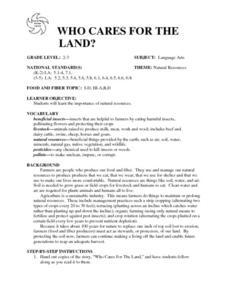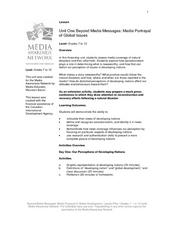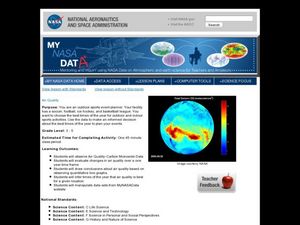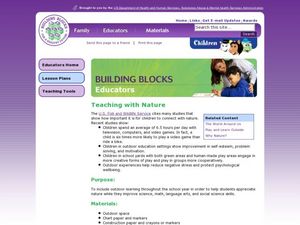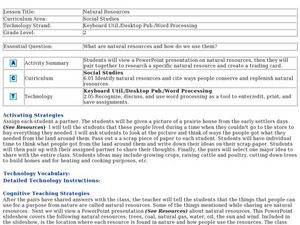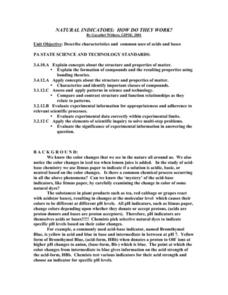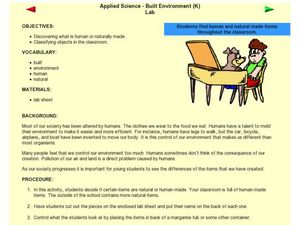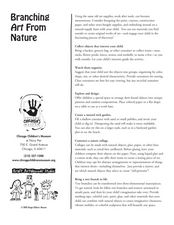Curated OER
Who Cares for the Land?
A very thorough lesson plan focuses on what plants need to grow and stay healthy. There are excellent reading activities and worksheets included in this fine plan. A terrific way to introduce a unit on plants and their needs.
Curated OER
Beyond Media Messages: Media Portrayal of Global Issues
Take a close look at news reporting techniques and global issues. Begin by creating a graphic representation of developing nations and defining the term. After class discussion, the second day's activities pick up by deconstructing news...
Curated OER
Fossil Fuels (Part II), The Geology of Oil
More of a mini-unit than a lesson, these activities lead inquisitors through a survey of oil deposits. In the first part, they read about and view diagrams of sedimentary rock layers that trap oil. Next, they test porosity and...
Nature Works Everywhere
Recording the Rainforest
Animals have evolved to communicate in different frequencies so they can hear each other throughout the rainforest. The first lesson in a three-part series begins by exploring an interactive story map online about the Borneo rainforest....
Cornell University
Fibers, Dyes, and the Environment
Nanofibers can be made through electrospinning or force spinning in order to reduce the negative impact on the environment. Pupils study the role of fibers and dye on the environment through a series of five hands-on activities. Then,...
Curated OER
Air Quality
Students observe air quality and monoxide data. In this air quality lesson, students draw conclusions and manipulate data from a one year period on changes in air quality.
Curated OER
The Ocean Floor and Shore Zones
Make textbook reading more engaging using this reading activities worksheet, through which scholars review major features found on the ocean floor and the processes that formed these features. They complete 11 terms in a crossword...
Curated OER
Who Wants to be a Millionaire? Solar System
Fifteen questions about our solar system make up this interactive review game. It was written by a teacher in the UK, and therefore the monetary winnings for answering correctly are in pounds. The content applies, however, to any...
Curated OER
Teaching with Nature
Students participate in a nature walk to learn about their natural environments. In this nature study lesson, students brainstorm a list of things to look for on their nature walk. Students go on the nature walk and locate objects they...
Curated OER
The Sounds Of Nature
Second graders investigate the concept of sounds in nature. The sound of a coqui frog is used as an example. They identify species of frogs by listening to the sounds they make. Also, 2nd graders experience and identify other sounds of...
Curated OER
Drawing From Nature
Learners observe similarities and differences of natural objects. In this observation lesson, students use a magnifying glass to identify the details of objects.
Curated OER
Types of Behavior: Animal Behavior Research
How does one determine what influences animal behavior; Is it nature or nurture? After a short reading explaining different types of conditioning and other learned behaviors, scholars examine six scenarios to determine whether the...
Curated OER
Ecology and the Conservation of Natural Resources
Students examine the habits of various organism and evaluate the need for conserving natural resources. They role-play as migrating birds traveling between habitats encountering hazards along the way. They observe animals in a...
Curated OER
Natural Disasters
Ninth graders write a description of a natural disaster. They list as many natural disasters as they can think of. The class discusses any natural disasters individuals have witnessed first hand. They watch a brief clip of a film that...
Curated OER
Natural Resources
Fifth graders begin the lesson by identifying the different types of natural resources. As a class, they discuss how environments are destructed and how the loss of one natural resource can affect the economy. Using a map, they label the...
Curated OER
Observing Natural Science in Action
In this observing science in action instructional activity, learners look at a picture and answer a set of 6 "observation questions." Answers are included on page 2.
Curated OER
Natural Indicators: How Do They Work?
Students describe characteristics and common uses of acids and bases. They describe the role of natural indicators in the chemistry of acids and bases after testing and making observations on a variety of plant extracts. Students observe...
Curated OER
Explorit's Nature Sounds Quiz #1
In this nature sounds worksheet, students take a quiz where they answer multiple choice questions about nature sounds and what animals make the sounds. Students answer 6 questions.
Curated OER
Human or Natural?
Students explore nature by participating in a class lab activity. In this human vs. nature lesson, students examine a group of items in their classroom and discuss whether they were created naturally or have been altered or created by...
Curated OER
Maisy's Nature Walks
Students participate in an interactive story instructional activity. They listen to a reading of Lucy Cousins, Maisy's Nature Walk, before completing post-reading activities. They examine the illustrations, discuss nature walks, and...
Curated OER
Natural Figures
First graders look for geometrical shapes in nature to help them appreciate the diversity of the natural environment.
Curated OER
Branching Art From Nature
Young scholars construct an art piece from nature. In this visual art instructional activity, students use objects from the environment (petals, leaves, and stones) to create a unique art piece.
Curated OER
The Vibrational Nature of Sound
Students explore the vibrational nature of sound. In this science lesson plan, students gain an understanding of sound frequency, pitch, and conduction using the string telephone, tuning fork and musical glasses experiments.
Curated OER
A Natural Habitat: What, How and Why
Students understand what a habitat is. They determine why a habitat is important to our environment no matter where it is located. Students observe and recognize natural habitats in their surroundings.


